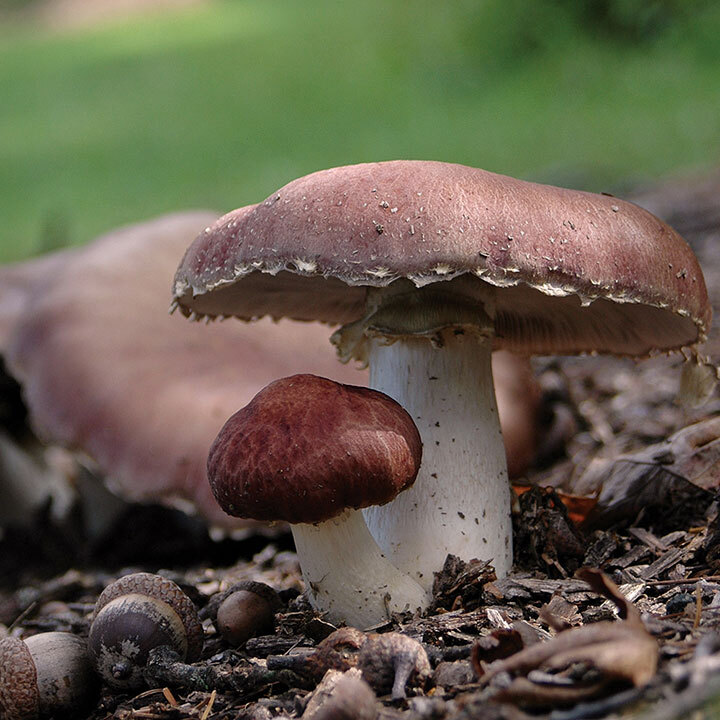
The Wine Cap mushroom is one of the easiest mushrooms to grow. It can be grown nearly anywhere outdoors on your property and requires no special tools to plant. Mushrooms require water and humidity to grow, so selecting an ideal location can really reduce your need for moisture management. Follow the six steps below for planting your Wine Cap mushroom bed.
Planting your Wine Cap bed
1. Select and prepare your substrate - wood chips, straw, or both?
Wood Chips: Wood chip beds can produce mushrooms for several years. Soft hardwood chips (box elder, cottonwood, willow, soft maple, magnolia, etc.) work best. Hardwood chips (oak, etc.) should be left outside to age for several months prior to use. Softwood chips should not be used, except in certain circumstances - primarily as a top layer over a straw bed to maintain moisture. If the wood chips are dry, water them with a sprinkler until wet before proceeding.
Straw: Straw beds can produce mushrooms quicker, but have a shorter overall life. Clean, weed-free straw (either oat or wheat) is best. Water the straw until uniformly wet or soak for 2-3 days to hydrate and condition it, then drain it before proceeding.
Mixture of both: The best of both worlds! Read about layering straw and wood chips in Step 3.
2. Select a bed location
Think about moisture maintenance! Shaded areas are best because beds will be less prone to drying out and require less watering. Full sun beds are possible but require more watering on your behalf. We like to plant in already mulched areas, under trees, on the shady side of houses, or in and around ornamental plants. The bed should have a soil floor or mulched surface, free from weeds and sod. Avoid raised bed structures as deep structures may smother the mycelium or the substrate may dry out in shallow beds. Avoid deeply forested areas with little air movement.
3. Planting the bed
Beds are created in layers, sandwiching the spawn between layers of substrate. Place your first layer of substrate down and then sprinkle spawn (broken into pieces) on top, and then another layer of substrate. If you are using straw and wood chips, alternate layers of straw, spawn, and wood chips. You can create multiple layers, but keep in mind that the more layers the longer it will take for the bed to start producing. One of our favorite ways is to place approximately 4 inches of soaked straw down first, followed by the entire bag of spawn, followed by 2-3 inches of wood chips. Ideally the top layer should be wood chips. Bed depth depends on the substrate you are using and location of the bed. Wood chips are less prone to drying out, so bed depth should be 3-5˝ if planted in spring to early fall, 6+ inches if planted in the late fall. Straw is more prone to drying out, so we recommend 6-8˝ (shaded beds can be shallower, sunny beds should be on the deeper side). Create a thicker top layer of substrate because that will protect the spawn underneath from drying out.
4. Maintaining and monitoring the bed
Again, think about moisture maintenance. We recommend checking your bed regularly at first. Dig down into the bed with your fingers – it should be damp, not wet. If it feels dry, then water with a sprinkler. A general rule of thumb is 1˝ water/week is ideal, but that depends on bed depth, sun exposure, and wind. A well-made bed in an ideal location may need little to no maintenance! While you are digging in the bed, keep an eye out for white, branching, thread-like material we call mycelium – kind of like the roots of the mushroom. That is a great sign of successful Wine Cap growth.
5. Mushroom harvest
Wine Cap are ready to fruit typically 2-11 months after planting. Keep an eye on your bed, especially after rainfall or temperature fluctuations. You can pick them when they are young in the button form, or wait another day or two for the cap to open. Simply pluck them from the bed using your hands, cut the bottom of the stem off, and store mushrooms in the refrigerator until you're ready to eat them.
*Always be sure to identify your mushrooms before you eat them. Please consult the website and additional resources for more information.
6. Bed rejuvenation
Wine Cap mushrooms break down the bed substrate quickly. For this reason, straw beds usually only fruit for a single year. Wood chip beds may fruit up for to 3 years, but production will decline over time. When this begins to happen, you may try to rejuvenate your bed by feeding it new wood chips. Simply add several inches of chips to the top of your existing bed, ideally in spring or after a mushroom harvest. Bed rejuvenation is not a guarantee, but if the Wine Cap is still vigorous enough, it will begin to colonize the new materials and be ready for more fruiting several months later. Consider adding new spawn to the fresh materials for a much more successful approach.
AT A GLANCE
Difficulty: Easy.